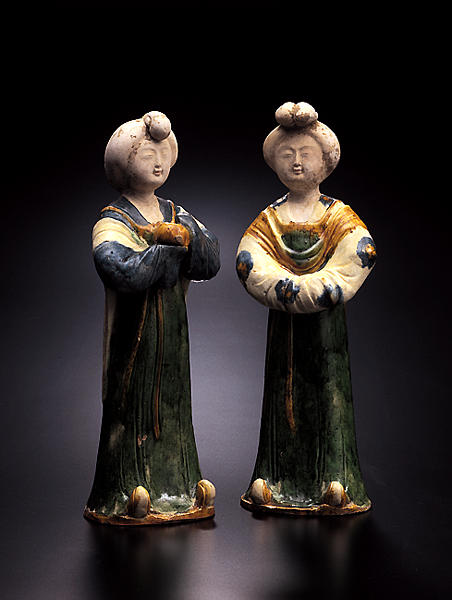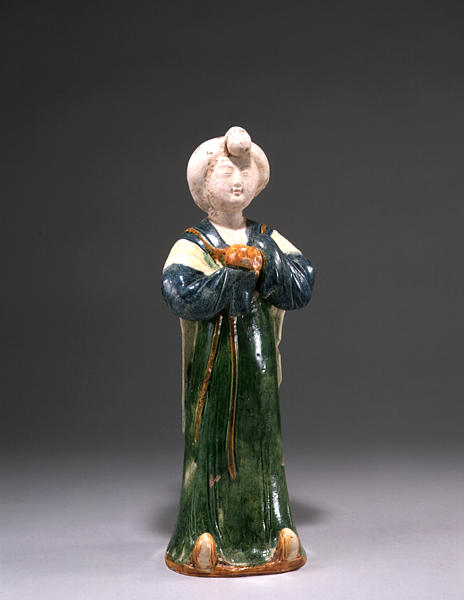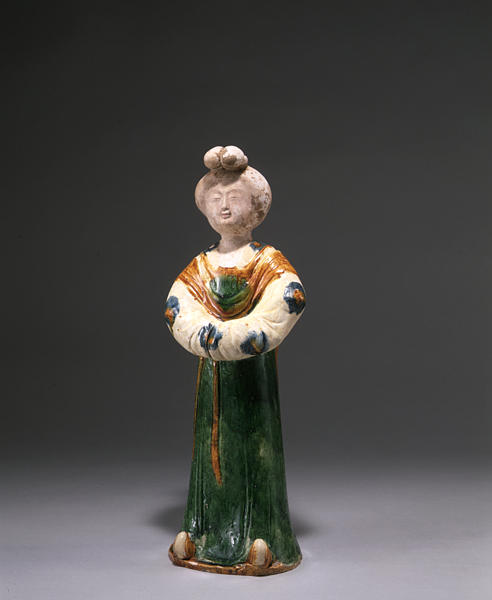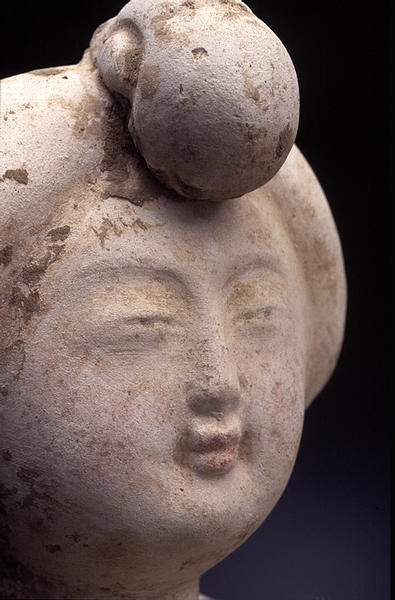立女俑
- 中国
- 中国・唐時代
- 8c
- 三彩陶製
- H-33.7
やや背の高い1体は,頂に双髻を結い,上半身に肩パット付きの筒袖,下半身には肩紐付きの胸下まである長裳を着用する。両手は筒袖の中に隠し,腹前で合わせている。肩掛けは腹前をわたり,両方の肩を覆って腰の左右に垂下している。裳裾から先の反り返った靴先がのぞいている。頭部から首にかけてを加彩とし,衣服部には緑,褐色,藍,白色の釉を施している。髪,眉,目を墨で描き,唇には朱をさしている。もう1体の俑も基本的には同様な服制を示しているが,頭頂の髷が単髻であることと,両手を筒袖のなかに隠しながら,胸前で小さな包みを奉持している点が異なっている。
7世紀から8世紀に至る女子俑の展開の中に、この2体の俑を位置づけるならば、おそらくは鮮于庭誨墓出土の諸作品よりは少し前、永泰公主墓出土の三彩女子騎馬俑よりは少し後くらいが想定しうる。前に掲げる珍と立女俑に比べると、均整のとれた頭体のバランス、衣服の下の微妙な肉体の起伏、筒袖に隠れた両手の動きなどの表現で写実性が進んでおり、釉の使い方も衣服や文様に合わせた細やかな使い分けが生まれるなど、やや後の時代の制作を感じさせる要素を持っている。
Catalogue Entry
The evolution of tomb figures is well documented by the abundance of recently excavated material. During the early part of the Tang dynasty (A.D. 618-907), clothing and coiffure styles popular during the previous Sui dynasty (A.D. 581-618) were still favored and featured on the narrow-hipped, slender-faced female tomb figures (compare cat. no. 127). By the eighth century, though, full-figured women with voluminous hairstyles were in vogue. Historical records list the wide variety of popular hairdos bearing such picturesque names as "the happy-traveling bun," the "worried bun," the "obedient bun," and the "alerted swan bun."1 Different versions of the "half-tuned bun" appear on the two full-figured Shumei tomb figures.
One tomb figure is slightly taller than her companion. Both wear a dress ensemble common during the Sui dynasty, but the eighth-century version features a jacket with wider sleeves. The empire-waisted design, cinched by a ribbon, perfectly accommodates a more expansive figure. By this time a cape, usually made of light, thin gauze and featuring either hand-painted or printed motifs, had become a popular addition to a lady's ensemble. These scarf-like capes, often measuring more than two meter longs, were draped over court women's shoulders and twined around their arms.2
The face and neck of each of the figures are unglazed. The hair, eyebrows, and eyes have been painted black and the lips touched with red. Both figures' dress ensembles are glazed in hues of green, brown, indigo, and white glazes. The taller figure's jacket features a pattern resembling the tie-dyed material that became popular during the Tang period. Early examples of tie-dyed fabric, more than likely from the West, have been excavated from fourth century tombs at Astana in Xinjiang province.3
Both figures' hands are concealed by voluminous jacket sleeves; however, the shorter figure's sleeves are raised to hold a small package. Both figures wear shoes with turned-up toes, favored foot apparel during Tang times.
Many tombs containing plumper female tomb figures have been excavated in Shaanxi province. Prefiguring them all, though, were female tomb figures excavated near Qiaoling, and dating from 684.4 The tomb of Princess Yong Tai (died in 701), also contained a plump, three-color-glazed female tomb figure, and a chubby three-color female figure was excavated from the Kai Yuan tomb near Xi'an.5 The Shumei female tomb figures featured here are dated slightly later than the female tomb figure with a dog (cat. no. 129).
HK
1. Zhou and Gao 1987, p.84.
2. Ibid., p.88.
3. 5000 Years Committee 1992, p.109.
4. Dait h no hana 1996, pl. 30.
5. Ibid., pl. 53.
解説(春の玉手箱)
この二体の立女俑は均整のとれた頭体のバランス,衣服の下の微妙な肉体の起伏,筒袖に隠れた両手の動きなどに見事な写実性を示しており,釉の使い方も衣服や文様に合わせた細やかな使い分けを見せている。
七世紀から八世紀に至る女子俑の展開は,近年の中国における制作年代のわかる発掘資料の増加によって,かなり具体的にたどれるようになったが、今このような七世紀から八世紀にかけての女性俑の作風展開のなかに,この二体の俑を位置づけるならば,恐らくは典型的な八世紀様を示している開元一一年(七二三)の西安南何村鮮于庭誨墓出土の三彩女子俑(中国歴史博物館蔵)よりは少し前,永泰公主墓出土の三彩女子騎馬俑よりは少し後くらいが想定しうる。このことからすれば、これらの俑も八世紀の初め頃に制作されたものと考えられよう。



